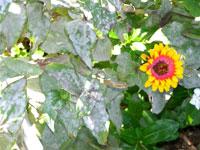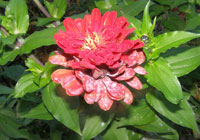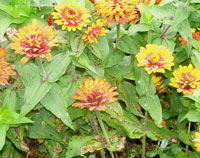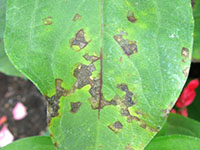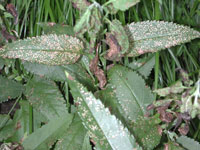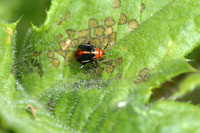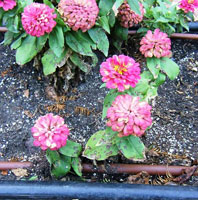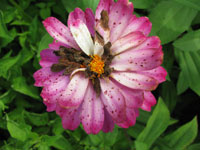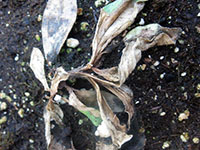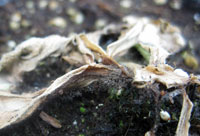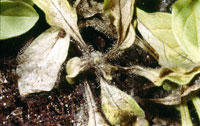Extension > Garden > Diagnose a problem > What's wrong with my plant? > Annuals and Perennials > Zinnia > Spots or blotches on leaves
Zinnia > Leaves > Spots or blotches on leaves
1 of 5
Powdery Mildew
Golovinomyces (syn. Erysiphe) cichoracearum
- Powdery, fluffy white spots and blotches on leaves, stems, and flower parts
- Tiny black round spheres may be visible within white spots late in the season
- Spots typically start on lower leaves but can spread to cover the entire plant
- Severely infected leaves may be completely covered in white or grayish white fungi
- In some cases, leaves become curled or twisted or turn yellow due to the infection
- More information on Powdery Mildew
2 of 5
Bacterial Leaf Spot
Xanthomonas campestris pv. zinniae
- Small brown to black angular spots surrounded by yellow halos on leaves
- Spots on petals are reddish and circular
- Spots may merge together creating larger dead black areas that dry and crack
- Disease starts on lower leaves and progresses up the plant
- More information on Bacterial Leaf Spot (3.46 MB PDF)
3 of 5
Four-Lined Plant Bug
Poecilocapsus
- Present May to early July
- Feeding causes brownish, round sunken spots on leaves
- Nymphs are red or red and black; adults are greenish yellow with 4 black stripes, ¼ to 1/3 inch long
- More information on Four-Lined Plant Bugs
4 of 5
Alternaria Blight
Alternaria zinniae
- Reddish brown circular spots up to ½ inch in diameter appear on leaves and petals
- Centers of spots turn grayish white
- Center of an older spot may fall out giving the leaf a shot-hole appearance
- Severely infected leaves, stems, and flowers turn brown and die
- Dark brown sunken lesions (cankers) are common on the stem near the soil line
- Warm, wet or humid weather favors disease
- More information on Alternaria Blight (3.46 MB PDF)
5 of 5
Gray mold
Botrytis cinerea
- Large brown spots or blotches on leaves
- Leaves or entire plant may be completely blighted, brown and wilted
- Blossoms or petals may turn brown and drop off prematurely
- Gray fuzzy mold develops on rotted tissue under humid conditions
- Disease develops during cool, wet weather
- Commonly on seedlings and young transplants
- More information on gray mold



